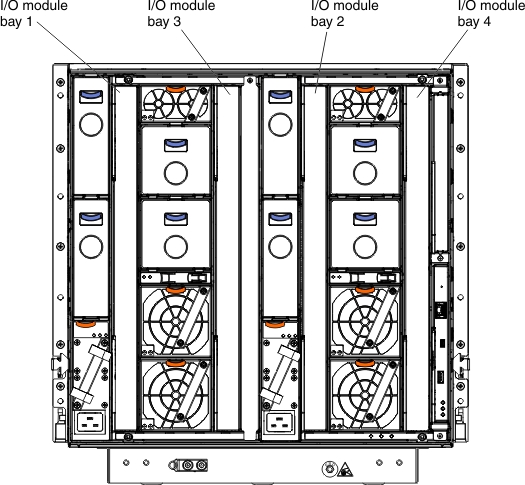I/O modules
You can install up to four I/O modules in the Flex System Carrier-Grade chassis, including Ethernet switch modules, Fibre Channel switch modules, Infiniband, and pass-thru modules (optical and copper).
The following is an illustration that shows the chassis I/O bays.

Warning: The intra-building port(s) (EN2092 I/O module Ethernet ports) of the equipment or subassembly are suitable for connection to intra-building or unexposed wiring or cabling only. The intra-building port(s) of the equipment or subassembly MUST NOT be metallically connected to interfaces that connect to the OSP or its wiring. These interfaces are designed for use as intra-building interfaces only (Type 2 or Type 4 ports as described in GR-1089) and require isolation from the exposed OSP cabling. The addition of Primary Protectors is not sufficient protection in order to connect these interfaces metallically to OSP wiring.
- For more information about the I/O modules that are available for the Flex System Carrier-Grade chassis, see the Flex System network devices information page.
- To determine which I/O modules are compatible with the Flex System Carrier-Grade chassis, see the Lenovo ServerProven website.
I/O module bays 1 and 2
I/O module bays 1 and 2 support Ethernet switches or pass-thru modules. These I/O bays connect to Ethernet ports 0 and 1 on the nodes installed in node bays 1 through 14. Most compute nodes feature two integrated Ethernet ports; for nodes without integrated Ethernet ports, an Ethernet expansion adapter must be installed in the I/O expansion port 1 connector of the node. See the documentation that comes with the node for more information about connecting it to the I/O modules in I/O bays 1 and 2.
I/O module bays 3 and 4
The I/O module bays 3 and 4 support optical and copper I/O modules such as Ethernet, Fibre Channel, and Infiniband switches, and pass-thru modules. To connect a node to a module in I/O bays 3 or 4, an expansion adapter that supports the I/O module is required. See the documentation that comes with the node for more information about connecting it to the I/O modules in I/O bays 3 and 4.